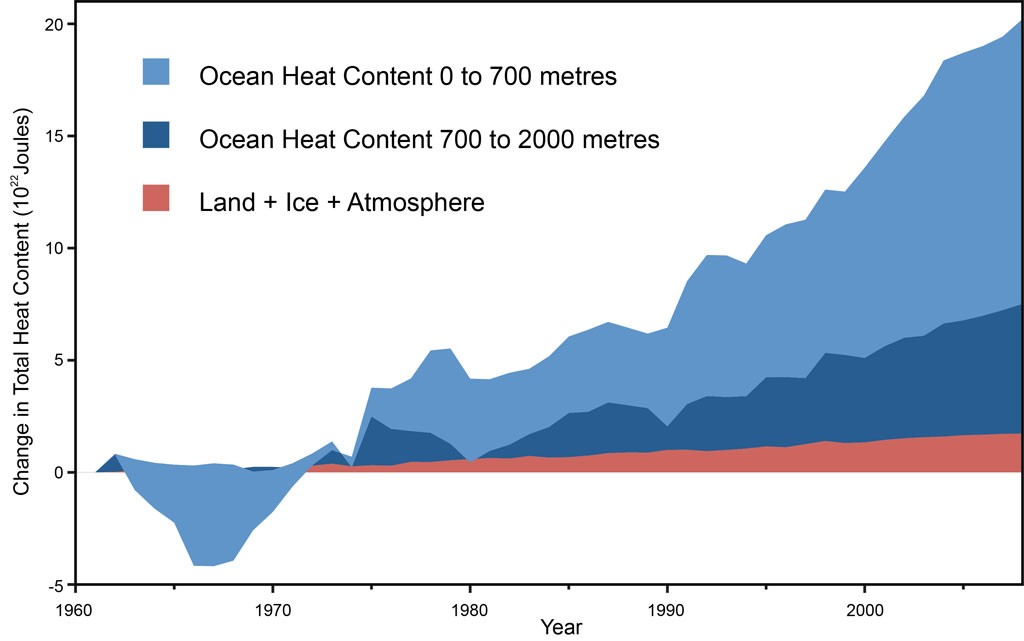CO2 Emission Levels Not Relative To Temperature

The amount of CO2 is increasing all the time – we just passed a landmark 400 parts per million concentration of atmospheric CO2, up from around 280ppm before the industrial revolution. That’s a 42.8% increase.
A tiny amount of CO2 and other greenhouse gases, like methane and water vapor, keep the Earth’s surface 30°Celsius (54°F) warmer than it would be without them. We have added 42% more CO2 but that doesn’t mean the temperature will go up by 42% too.
There are several reasons why. Doubling the amount of CO2 does not double the greenhouse effect. The way the climate reacts is also complex, and it is difficult to separate the effects of natural changes from man-made ones over short periods of time.
As the amount of man-made CO2 goes up, temperatures do not rise at the same rate. In fact, although estimates vary – climate sensitivity is a hot topic in climate science, if you’ll forgive the pun – the last IPCC report (AR4) described the likely range as between 2 and 4.5 degrees C, for double the amount of CO2 compared to pre-industrial levels.
So far, the average global temperature has gone up by about 0.8 degrees C (1.4 F).
“According to an ongoing temperature analysis conducted by scientists at NASA’s Goddard Institute for Space Studies (GISS)…the average global temperature on Earth has increased by about 0.8°Celsius (1.4°Fahrenheit) since 1880. Two-thirds of the warming has occurred since 1975, at a rate of roughly 0.15-0.20°C per decade.”
Source: NASA Earth Observatory
The speed of the increase is worth noting too. Unfortunately, as this quote from NASA demonstrates, anthropocentric climate change is happening very quickly compared to changes that occurred in the past (text emboldened for emphasis):
“As the Earth moved out of ice ages over the past million years, the global temperature rose a total of 4 to 7 degrees Celsius over about 5,000 years. In the past century alone, the temperature has climbed 0.7 degrees Celsius, roughly ten times faster than the average rate of ice-age-recovery warming.”
Source: NASA Earth Observatory
Small increases in temperature can be hard to measure over short periods, because they can be masked by natural variation. For example, cycles of warming and cooling in the oceans cause temperature changes, but they are hard to separate from small changes in temperature caused by CO2 emissions which occur at the same time.
Tiny particle emissions from burning coal or wood are also being researched, because they may be having a cooling effect. Scientists like to measure changes over long periods so that the effects of short natural variations can be distinguished from the effects of man-made CO2.
The rate of surface warming has slowed in the past decade. Yet the physical properties of CO2 and other greenhouse gases cannot change. The same energy they were re-radiating back to Earth during previous decades must be evident now, subject only to changes in the amount of energy arriving from the sun – and we know that has changed very little. But if that’s true, where is this heat going?
The answer is into the deep oceans. Here is a graphic showing where the heat is currently going:

The way heat moves in the deep oceans is not well understood. Improvements in measurement techniques have allowed scientists to more accurately gauge the amount of energy the oceans are absorbing.
The Earth’s climate is a complex system, acting in ways we can’t always predict. The energy that man-made CO2 is adding to the climate is not currently showing up as surface warming, because most of the heat is going into the oceans. Currently, the heat is moving downwards from the ocean surface to deeper waters. The surface gets cooler, humidity reduces (water vapor is a powerful greenhouse gas), and air temperatures go down.
The rate at which surface temperatures go up is not proportional to the rate of CO2 emissions, but to the total amount of atmospheric CO2 added since the start of the industrial revolution. Only by looking at long-term trends – 30 years is the standard period in climate science – can we measure surface temperature increases accurately, and distinguish them from short-term natural variation.

 Print
Print